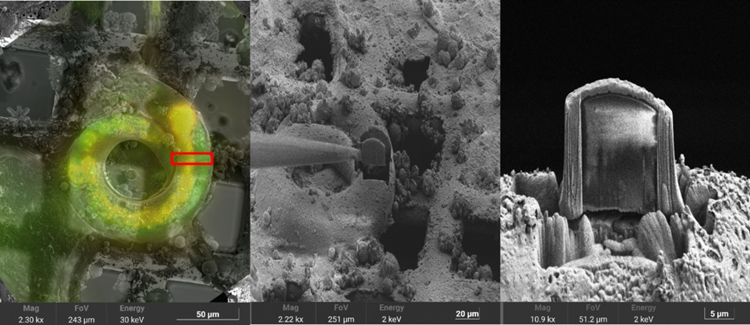Versatile Cryo-FIB Lamella Lift-out for Cryo-electron Tomography and Material Analysis
- Abstract number
- 273
- Presentation Form
- Poster
- DOI
- 10.22443/rms.mmc2023.273
- Corresponding Email
- [email protected]
- Session
- Poster Session Two
- Authors
- Samuel Záchej (2), Dominik Pinkas (1), Martina Zánová (2), Vlada Filimonenko (1), Rostislav Váňa (2), Jakub Javůrek (2)
- Affiliations
-
1. Institute of Molecular Genetics of the Czech Academy of Sciences
2. TESCAN
- Keywords
life sciences, in situ, structural biology, high pressure freezing, material science, electron microscopy, cryo, lift-out, FIB-SEM, scanning electron microscopy, lamella, nanomanipulator, cryo-electron tomography, TEM, sample preparation, correlative mIcroscopy, CLEM
- Abstract text
We present our optimised solution for lamella lift-out from frozen biological specimens, which includes a dedicated FIB milling strategy and a newly developed cooled TESCAN Cryo Nanomanipulator (NM). Employing a special milling geometry, we can reliably lift the lamella out of the frozen bulk sample while maximising the effective area of the lamella.
The proposed milling strategy avoids direct interaction between the ion beam and the face of the lamella, thus preventing potential heat damage, and enables the lamella to be approached by the NM from the side instead of from either the top or front. The ion beam is then used to re-deposit material locally, forming a bond between the NM tip and the lamella [1].
Since we use gas-injection-free welding, the sample surface and the NM tip are kept clean, and we were able to perform multiple lift-outs per session. Utilizing high pressure freezing protocols [2] and adopting them for cryo lift-out, we have been able to increase the precision of the correlation between light- and electron-microscopy data, giving an example of our study of C. Elegans. In addition to biological applications, we used the lift-out method to extract the lamella from commercially available solid-state battery, which was followed by further material analysis.
The workflow is reliable for various samples and can be used routinely for cartridge-based or side-entry cryo TEM stages. Moreover, the cryo lift-out method is not limited to biological samples but can also be used for analysis of sensitive materials such as polymers or batteries.
- References
[1] Parmenter, C.D. and Nizamudeen, Z.A., Journal of Microscopy, 281: 157-174 (2021), https://doi.org/10.1111/jmi.12953
[2] Harapin, J., Börmel, M., Sapra, K. et al. Structural analysis of multicellular organisms with cryo-electron tomography. Nat Methods 12, 634–636 (2015). https://doi.org/10.1038/nmeth.3401

